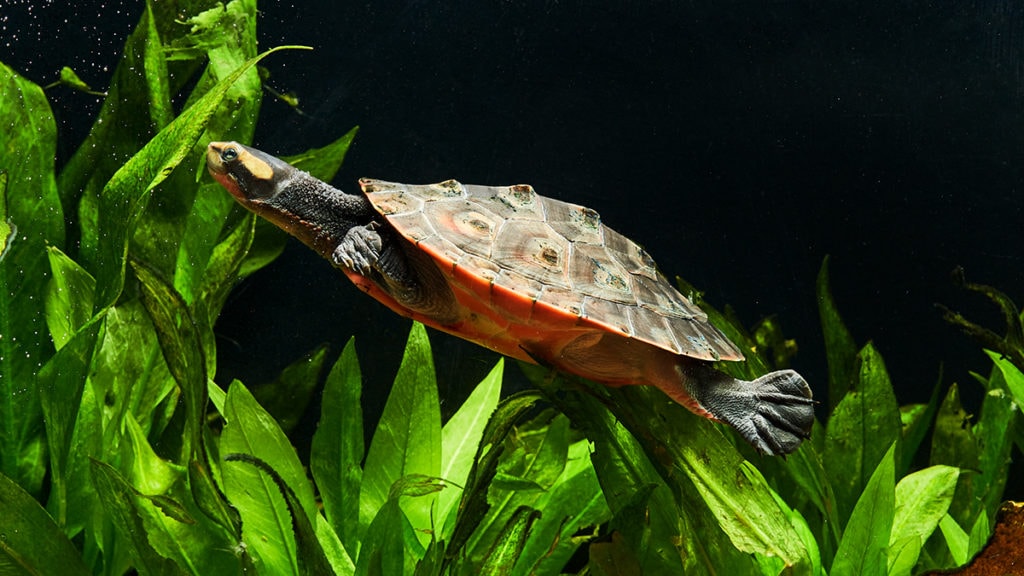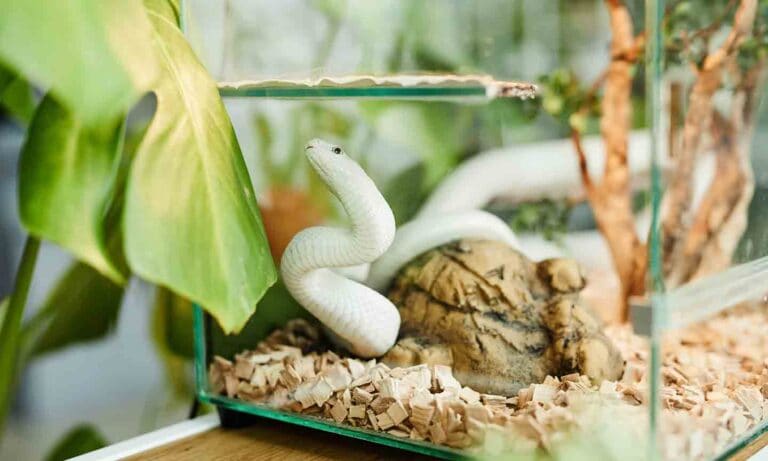So, you’ve decided to get a pet turtle. Whether you’re a turtle fanatic (like myself!), you’ve found yourself in possession of an aquatic turtle or you’re a parent looking for a “low-maintenance” pet for your family, a pet turtle is a great choice. And I’m here to walk you through proper care of your new pet.
Take a deep breath—you’ve come to the right place. I’ve worked with turtles my entire life, starting as a hobbyist, then as a reptile keeper at several zoos and now as a veterinarian specializing in turtles and tortoises.
Below is an overview of turtle care for the most common aquatic pet species—sliders, painted turtles, cooters and other pond/river turtles. This guide is a jumping off point into successful keeping and care of pet turtles—an educational and emotionally rewarding experience.
Essential Turtle Equipment
- Enclosure. A turtle tank and turtle aquarium are standards, but today, there also are plenty of alternatives, like turtle tubs and ponds.
- Light/Heat. Turtles are cold-blooded. To swim, digest, grow and maintain their immune system, turtles need UVB light and heat. This can be provided with separate bulbs or in combination with a mercury vapor bulb.
- Basking Site. Turtles thermoregulate (control their body temperature) by basking, which is when they get completely out of the water to warm up and dry off.
- Filtration. Clean water is critical to a healthy turtle, and it avoids a smelly room.
- Food. Like other pets, turtles need a complete commercial food staple, with occasional treats.
- Enrichment. Turtles are curious! Adding decor to their home is vital to keep them healthy and stimulated. Fake plants, like Marineland Bamboo, can provide security and a place to rest.
Choosing an Enclosure
Ideally you begin this process before getting your pet turtle. Turtle tubs and DIY ponds can be customized and provide more space to your pet, but many people prefer the aesthetics of a turtle tank or turtle aquarium as it allows you to observe the animal underwater.
The enclosure should be as large as possible for the adult size of the animal. I recommend nothing smaller than 75 gallons for most aquatic turtle species. Note: Females of most species get larger than males, which is something to consider if space is a concern.
Smaller turtles, like mud and musk turtles, can thrive in a 40-gallon, long aquarium their entire lives. A sturdy stand is a must, as 40 gallons of water can weigh over 300 pounds.
Avoid placing the aquarium in places with large fluctuations or extremes in temperature. This includes areas like drafty doorways, garages and near certain windows.
Setting Up Your Turtle Aquarium
After placing the enclosure where you want it, add in the decor.
For beginners, I strongly recommend against using substrate, such as sand, gravel, pebbles or river rocks, to line the bottom of the turtle tank. Substrate tends to collect debris and accidentally can be eaten, which can cause impaction or death. If you must get substrate, use large river rocks or washed calcareous sand.
Avoid décor items with large holes or those that potentially could fall, as turtles can drown if they get pinned or wedged. I stick with plastic plants and driftwood, which can create platforms your turtle needs to rest, sleep and reach the surface for air.
Next, add the basking spot. The Penn-Plax Turtle Topper above tank basking platform allows you to completely fill the aquarium with water and create an elevated, dry basking spot. And it doesn’t pose a drowning risk, like rocks and logs can.
Some turtle tubs include a built-in basking site similar to this platform. DIY platforms, rocks and logs can be used, but take precautions to ensure they cannot be moved by your pet turtle and crush or pin him.
Floating basking sites often don’t support the weight of adult turtles, but they can be used as a secondary resting area. Once you’ve placed the basking site, hang your light and heat above it.
Add Light and Heat
Your turtle needs both light and heat to thrive. Essential light for your pet turtle should offer both visible light and ultraviolet light (in the form of UVB).
Heat and visible light can be provided with an incandescent spotlight between 60 and 100 watts. Base the wattage on whatever gets the basking site to 90-100 degrees Fahrenheit during the day.
The UVB light can come from a UV compact fluorescent light.
Leave lights on for at least 10 hours per day. I use an outlet timer to automatically turn on the lights at 9 a.m. and shut them off at 10 p.m.; that way I can enjoy feeding and watching my turtles after I return from work.
Zoo Med Aquatic Turtle UVB & Heat lighting kit provides all the lights and fixtures needed for your turtle tank in one simple kit. If you don’t want to mess with multiple bulbs, then consider a mercury vapor bulb over 100 watts, like the Zoo Med PowerSun UV mercury vapor reptile lamp, and a fixture with a ceramic base, like Fluker’s Mini Sun Dome lighting fixture. Note: Mercury vapor bulbs get very hot and can shatter if water is splashed on them.
Keep your pet turtle’s water temperature in the range of 68-80 degrees Fahrenheit for him to keep feeding and remain active. Zoo Med ReptiTemp digital infrared thermometer is a useful tool to check temperatures within your turtle tank.
If the water temperature reaches the 50s, it can trigger a state of dormancy or hibernation. This is unnecessary for captive turtles and is beyond the average keeper’s skill set. If you find your water temperature is too cold, you can add a shatterproof aquarium heater, like the 100W Aqueon Preset aquarium heater.
Keeping Your Turtle Tank Clean
Yes, you need a filter. Yes, turtle tank filters can be pricey. But it will save you time and money in the long run and can turn keeping turtles from a chore into a relaxing part of your home.
I recommend a canister filter, a pond filter or a sump (wet/dry) filter. These all maximize the biological filtration surface area, which is the site where aerobic bacteria grow to break down solid waste. For most aquatic turtle keepers, a canister filter, like the Penn-Plax Cascade Aquarium canister filter, is the most economical, smallest and quietest option.
Whatever filter you choose, never go by the gallons on the box. Get something rated for a minimum of 75 gallons (a flow rate of approximately 265 gallons per hour) for a single juvenile to adult turtle. Then add a rating of 50 gallons for each additional turtle. The reason you should do this is because filter recommendations are almost always for fish tanks, but turtles are messy eaters, and tend to eat more food and have more solid waste.
To maximize your turtle tank filter’s capability, you will need to employ filter media with maximum surface area for the bacteria to colonize. Filter media is a term for any material used to trap debris in your aquarium and grow beneficial bacteria to break down waste. The media is placed in the filter boxes or chambers within your filter and water flows through them by the water pump.
Bio-filter balls, ceramic rings, sponge pads and filter pads are all examples of filter media, and can be used alone or in combination. However, it is generally recommended to use a filter pad or sponge pad in the early filter stages to trap larger debris and prevent clogging of the pump.
Biological media should be rinsed of debris every 1-2 months, using unchlorinated water to keep the beneficial bacteria alive. Replace any damaged or broken-down filter media with new filter media.
Activated charcoal can be added to the filter box to help “polish” the water (keep it clear) and eliminate odors. However, charcoal must be completely replaced every 1-2 months to remain effective.
Adjust the current from the filter outflow to be gentle to moderate. This is generally achieved by a flow control knob on the top of the filter, an intake valve or an outflow valve. The gentle flow will allow your turtle to be able to rest and sleep in the water without constantly treading water.
Feeding Your Pet Turtle
You will find that turtles are very food motivated. They quickly become beggars and will have you trained to giving them treats in no time!
Like other pets, aquatic turtles can become obese or deformed without proper nutrition. So start with a commercial turtle food as your pet’s staple diet. Zoo Med Natural Aquatic Maintenance Formula turtle food and Mazuri Aquatic turtle food are two used in zoos and aquariums worldwide for dozens of species.
Hatchling formulas contain smaller pellets, which may be necessary for young turtles. Feed the recommended portions by placing the pellets directly into the water. Most all aquatic turtles need to eat while in the water.
Add variety to your turtle’s diet for complete nutrition. Live foods, like crickets, wax worms, super worms and earthworms, are readily devoured, especially by young turtles, who tend to be more carnivorous.
Adult turtles also enjoy nibbling on fresh produce. I recommend floating pieces of dandelion, duckweed, water hyacinth, kale and other leafy greens.
Enjoying Your Pet Turtle
I strongly recommend researching your specific pet turtle species before bringing him home. And keep in mind that turtles can live 30-50 years on average, so they can be a part of your family for decades.
As with all pets, watch their weight, appetite, activity and appearance so you quickly notice signs of illness. And, most importantly, have fun!
Many turtles love to interact with their human families. Taking walks outside of their tanks, getting their shells scrubbed with a toothbrush and getting to bask outdoors while supervised often are enjoyable experiences for a pet turtle. Just be sure to exercise good judgement, proper hygiene and common sense.
With these notes in mind, your pet turtle should live a happy and healthy life.
Author’s Note: Adopt, don’t shop! People are surprised to hear that abandoned turtles are a huge issue in many cities. I get calls every day about people looking to rehome turtles who have grown too large for them, keepers going off to college and, sadly, animals who outlive their families. Most cities have animal shelters and reptile clubs that adopt out reptiles for free or a small fee. A quick search on Google or PetFinder.com can guide you in the right direction. By adopting, you help prevent pets from being released into the wild where they have become a major environmental issue.
Dr. James Liu grew up in California, obsessed with all things animals, especially reptiles. He graduated from UCLA in Conservation Biology and UC Davis School of Veterinary Medicine with a specialty in wildlife. He currently lives in New York and travels the world, working as the veterinarian and managing director for the Turtle Conservancy (@turtleconservancy). His articles and photography can be found in The Tortoise magazine, Reptiles magazine, LA Times, PENTA magazine, and on Chewy’s blog, BeChewy. Follow Dr. James Liu’s wildlife and turtle adventures on Instagram at @turtlesarentslow.
Featured Image: Via Chewy Studios
Share:


















